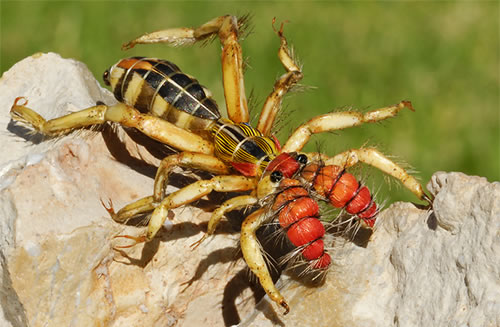Camel Spider – Camel Spider Facts – and Camel Spider Video
Camel Spider - Found in Deserts
Camel spiders are called camel spiders because they are normally found in the desert where you are likely to find camels – they have nothing to do with camels.
Camel spider belongs to the class Arachnida just as true spiders and scorpions. But whilst a camel spider belongs to class arachnida it is not a spider and it’s not a scorpion. A camel spider belongs to the order Solifugae within arachnida class whilst the true spider belongs to the order Araneae and the scorpion to the order Scorpiones but all within the arachnida class. This means a camel spider, true spider, and scorpion are related by different.
Camel Spider

Camel Spider Appears to have Ten Legs
All arachnids are joint-legged invertebrate animals. They have eight legs and in some species the front pair may convert to a sensory function.
The camel spider will appear to have ten legs. This is because the front jaws or palps are long and look like legs. These front appendages are for feeding, defense, and sensory perception.
Camel spiders can reach a length of 15cm when stretched out but the normal size is about 3cm. The abdomen of a camel spider has eleven segments and there is no segment separating the head from the abdomen. The camel spider has two visible eyes and five racket organs which are considered to be rudimentary eyes just as in scorpions. Camel spiders are carnivores and their diet includes small rodents, spiders, insects, termites, small lizards, etc

Camel Spider will Chase You at High Speeds
If you get closer to a camel spider during a sunny day, the camel spider will chase you at a high speed of up to 5 meters per second. They do this as they try to flee from the sun thus chasing your shadow. A camel does not have venom nor do they have silk glands. They do kill their prey with their powerful jaws which are also used for chewing the prey.
And yes, a camel spider will bite you and if the wound is not treated it can get infection. The camel spider will usually rub its jaws (stridulatory organ) together producing a hissing sound which make them very scaring to some people when they produce that hissing sound. True, the hissing sound is really a defensive function for the camel spider.
Indirect Mating
A camel spider is capable of doing both direct mating and indirect mating. The indirect mating involves sperm transfer - the male camel spider will emit a spermatophore on the ground and then will use the chelicerae to inserts the spermatophore into the female camel spider's genital pore.
Camel Spider as a Pet
You can keep a camel spider as pet but before you do that you need to have experience with scorpions as camel spiders are equally very aggressive.
Camel Spider Video
If you have liked this article, and you would want this page to keep up and improved, you can help in any way you can. A free way to help would be to link back to this webpage from your web page, blog, or discussion forums.
The Author’s page is designed to help beginners and average readers make some money as an extra income to supplement what they may be earning elsewhere - details of which you can find in My Page, if you will.









